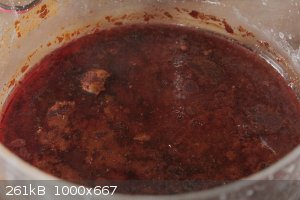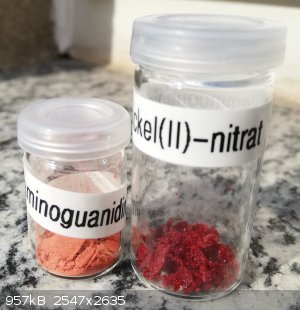Hey Buddy
Hazard to Others
  
Posts: 384
Registered: 3-11-2020
Location: Bushwhacker Country
Member Is Offline
|
|
Nitroguanidine reduction product
I asked this in SQ/QA but no answer yet, I'm going to destory this today if I cant identify it. --I was recently attempting to reduce NQ via
electrolysis. I used a copper anode which is a basic mistake, forgetting it produces this red substance. I am unable to ID from literature, I have
been searching Thiel, Lieber, Kurzer but cant seem to find where this substance is mentioned. I know I have read it somewhere before, but now that its
relevant I cant recall. I think its a Tetrazine but want to be sure of ID before disposal. If it's a tetrazine it might be a simple precursor for an
energetic tetrazine complex, in which case I may just roll with it. Thanks.

|
|
|
Microtek
National Hazard
   
Posts: 827
Registered: 23-9-2002
Member Is Offline
Mood: No Mood
|
|
I have no idea what that is, but I would suggest you begin by isolating it and then testing it for Cu-ions.
|
|
|
Boffis
International Hazard
    
Posts: 1836
Registered: 1-5-2011
Member Is Offline
Mood: No Mood
|
|
Under rather specific conditions with conventional reducing agents it is possible to reduce some nitro guanides and ureides to what are effectively
1,2-disubstituted hydrazine and some of these are readily oxidized to stable azo-guanyl compounds which are deep yellow to orange red. I still have a
crop of such material prepared more than a decade ago waiting to be investigated. It is sparingly soluble in most solvents making it difficult to
purify but if I recall it was prepared by the reduction of nitroguanidne with zinc. I will check my note books when I get home in a weeks time if you
like. For references on these compounds check out von Richter's chemistry books.
|
|
|
Hey Buddy
Hazard to Others
  
Posts: 384
Registered: 3-11-2020
Location: Bushwhacker Country
Member Is Offline
|
|
I threw it out, but it can be replicated later. If anyone is interested in how it was made: Anolyte 10% H2SO4 / copper anode. Catholyte 30% (NH4)2SO4
+ NQ mixed in undissolved / lead cathode. No temp control, ~5 amps, unknown surface area of electrodes. It turns red very slowly at first then becomes
more exponential. I let it run for about 12 hours and it was white NQ floating in sulfate solution at first then arterial-blood-red after a night.
[Edited on 16-12-2022 by Hey Buddy]
|
|
|
Boffis
International Hazard
    
Posts: 1836
Registered: 1-5-2011
Member Is Offline
Mood: No Mood
|
|
Is the stuff floating in the red liquor actually red or just the solution? I checked out Richter vol 1 pages 504-505 and 516 there are several
possibilities but H2N-CO-N=N-CO-NH2 is described as a sparingly soluble orange red solid. The only mention of colour for the guanyl derivatives is the
nitrate salt of H2N-CNH-N=N-CNH-NH2 a sort of azobiguanyl which is yellow but the free base may not be.
|
|
|
Hey Buddy
Hazard to Others
  
Posts: 384
Registered: 3-11-2020
Location: Bushwhacker Country
Member Is Offline
|
|
I think the material is red when it is converted to completion but it begins as white NQ and then becomes tan then orange then red. I didnt continue
the conversion because it was in error.
I also forgot to mention for anyone reading that I used a diaphragm for the copper anode. Clay flower pot with the H2SO4 anolyte inside and the
NH42SO4/NQ on the outside with a stir bar.
|
|
|
Hey Buddy
Hazard to Others
  
Posts: 384
Registered: 3-11-2020
Location: Bushwhacker Country
Member Is Offline
|
|
I stumbled across the old article my brain was remembering about possible identities of this material. Then found the Thiele reference. There is a
1953 paper of lieber. Synthesis of Sym-diaminotetrazine. I suspect that this red product may be a 3,6-diamino 1,2,4,5 tetrazine or a derivative of it.
A red/violet product from the action of potassium hydroxide on aminoguanidine HCl.-Lieber.
Also, Thiele obtained a red crystal from attempting to isolate free aminoguanidine by precipitation of the sulfate with barium hydroxide. I dont know
whats going on but if it is forming a tetrazine, NQ could be reducing to aminoguanidine and then cyclizing to tetrazine. Boffis' suggestion also seems
plausible...
just found these articles today and wanted to update this in case anyone wanted to know of possible easy route to tetrazines.
[Edited on 21-10-2023 by Hey Buddy]
|
|
|
Diachrynic
Hazard to Others
  
Posts: 219
Registered: 23-9-2017
Location: western spiral arm of the galaxy
Member Is Offline
Mood: zenosyne
|
|
The red color of aminoguanidine self-condensation/oxidation was initially ascribed to the formation of diaminotetrazine by Ponzio and Gastaldi in 1913. After the compound had been made by Lin and Lieber in 1954 (the paper you mentioned!) it was established that the red product is not just diaminotetrazine:
| Quote: | | In conclusion, it is pertinent to mention that the properties manifested by VIIa [3,6-diamino-1,2,4,5-tetrazine] are distinctly different from those
originally attributed to this structure by Ponzio and Gastaldi. The structure of the Ponzio product will be the subject of a future communication.
|
No follow-up communication ever came as far as I know. However, in 2014 the structure was determined by another group, and it is in fact not a
tetrazine.
B. Tasso, G.Pirisino, F. Novelli, D. Garzon, R. Fruttero, F. Sparatore, A. Sironi, Tetrahedron 2014, 70, 43, 8056–8061. https://doi.org/10.1016/j.tet.2014.08.037
Attachment: tasso2014_aminoguanidine_self_condensation.pdf (675kB)
This file has been downloaded 82 times
| Quote: | | The structure of 3,6-diamino-1,2,4,5-tetrazine was assigned to the red-violet compound that was obtained by treating aminoguanidine hydrochloride with
KOH by Ponzio and Gastaldi in 1913. At present, one century later, through a chemical and spectroscopic study, the structure of
1,1,4,10,10-pentaamino-2,3,5,6,8,9-hexaazadeca-1,3,5,7,9-pentaene was attributed to that compound. |
we apologize for the inconvenience
|
|
|
EF2000
Hazard to Others
  
Posts: 103
Registered: 10-5-2023
Location: The Steppes, now trapped in the forest zone
Member Is Online
Mood: wrooom
|
|
Since there at least some aminoguanidine is present, can it be copper aminoguanidine sulfate complex?
Cu(AG)2(ClO4)2 is said to be violet here: Z. anorg. allg. Chem. (attached it too)
But as seen in attached picture (found somewhere on SM wiki and cropped), nickel sulfate complexes differ in color from nickel perchlorate ones. Maybe
it's also true for copper. Kinda similiar orange, isn't it?

Attachment: Synthesis, Structural and Energetic Properties of Copper(II) Perchlorate Complex with Aminoguanidine.pdf (1MB)
This file has been downloaded 92 times
[Edited on 21-10-2023 by EF2000]
[Edited on 21-10-2023 by EF2000]
|
|
|
Diachrynic
Hazard to Others
  
Posts: 219
Registered: 23-9-2017
Location: western spiral arm of the galaxy
Member Is Offline
Mood: zenosyne
|
|
The copper aminoguanidine complexes look nothing like the picture in the OP. All of them are some shade of blue or purple. Not red like nickel, that's
just a common color for square planar complexes.
I wouldn't exclude Cu2O in part for the red color in the OP though.
(Also thanks, that's my picture  ) )
we apologize for the inconvenience
|
|
|
EF2000
Hazard to Others
  
Posts: 103
Registered: 10-5-2023
Location: The Steppes, now trapped in the forest zone
Member Is Online
Mood: wrooom
|
|
Quote: Originally posted by Hey Buddy  |
I also forgot to mention for anyone reading that I used a diaphragm for the copper anode. Clay flower pot with the H2SO4 anolyte inside and the
NH42SO4/NQ on the outside with a stir bar. |
Alright, copper complex excluded. My second attempt: what about iron? If the pot in question is made from red clay, iron could leach out. The color is
pretty rusty
(Also, great picture, Diachrynic ) )
[Edited on 21-10-2023 by EF2000]
Wroom wroom
|
|
|
Hey Buddy
Hazard to Others
  
Posts: 384
Registered: 3-11-2020
Location: Bushwhacker Country
Member Is Offline
|
|
| Quote: | Quote: Originally posted by Diachrynic  | | At present, one century later, through a chemical and spectroscopic study, the structure of
1,1,4,10,10-pentaamino-2,3,5,6,8,9-hexaazadeca-1,3,5,7,9-pentaene was attributed to that compound. |
|
I wonder if that is the molecule. Very strange one. Begging to be cyclized. Maybe some oxalic acid. I dont suspect a metal interaction. I think it's
simply the metal electronic character and maybe combination of anode/cathode that produces the red molecule. Electrolytic energetics are really
creepy.
[Edited on 22-10-2023 by Hey Buddy]
|
|
|